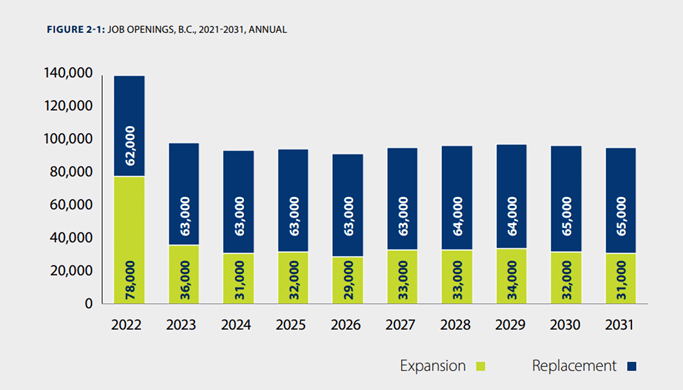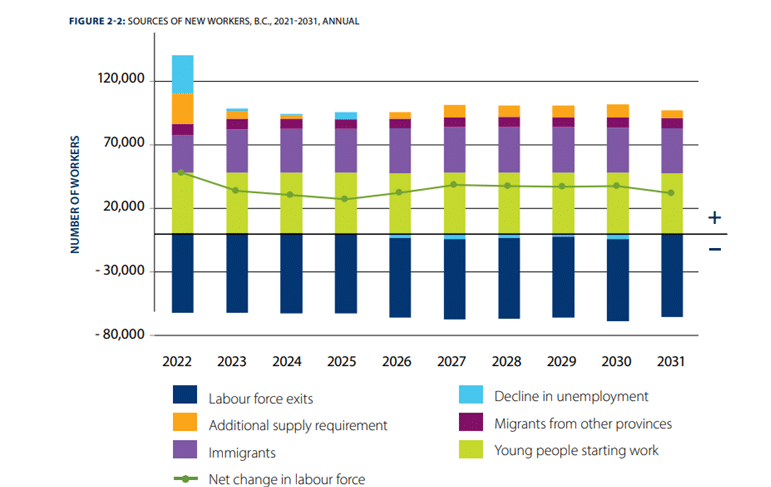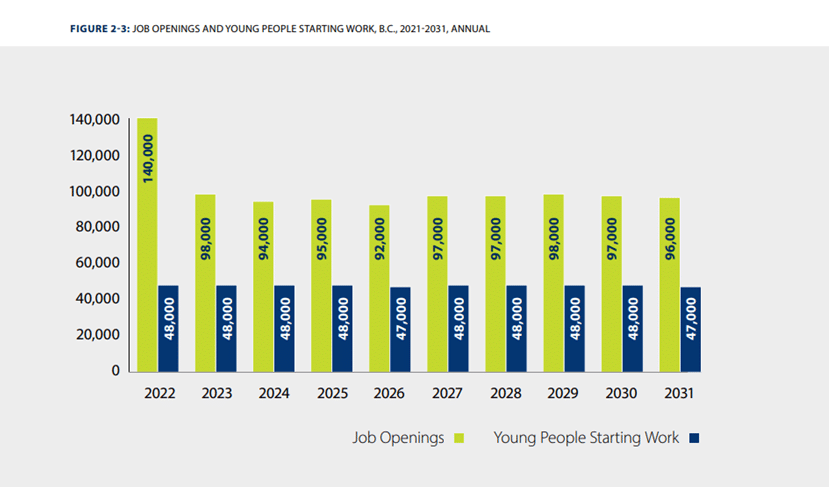This report provides British Columbians and others across Canada and worldwide with a picture of Canada’s employment future. It discusses the supply and demand for labor: for those seeking employment and those providing it. Several factors are shaping the future of British Columbia, including COVID-19 and climate change.
It is imperative to support meaningful reconciliation with Indigenous Peoples and build an innovative, sustainable, and inclusive economy to address these challenges. Developing and expanding industries will need skilled workers to keep pace with rapid change. British Columbians need to ensure that their province is prepared to meet those demands in the future. British Columbians can look forward to a decade full of opportunity and prosperity in the coming decade.
This report will:
- Identify the best opportunities in each province region and how to prepare them for young people and those in the workforce across our economy.
- Provide information about the province’s people and skills to investors and employers. Planners of education and training can use it to determine what demand to expect.
- Forecast job openings and strong labor demand in British Columbia that everyone in the province can take advantage of.
The proper support and training opportunities can benefit Indigenous people, women, people of color, people with disabilities, and other underrepresented groups in the labor market. The report shows that nearly 80 percent of job openings require postsecondary education within the next ten years. Getting good family-supporting jobs will help people build their lives and the lives of their families and loved ones. Let’s look into this report in more detail!
10-year Overview
According to the B.C. Labour Market Outlook, there will be 1,004,000 job openings in British Columbia from 2021 to 2031. Employers will need to replace retiring workers as the population and labor force continue to age. There are approximately 635,000 job openings for replacements. Sixty-three percent of job openings are required to replace permanent workers leaving the workforce. The remaining 369,000 job openings are expansions.
That means either COVID-19 recovery or new economic growth will create 37 percent of all job openings over the next decade. The number of employees will reach 3 million by 2031, up from 2.6 million today. It is forecast that employment will grow by 1.5 percent a year during the first five years of the forecast and by 1.1 percent during the last five years. Growth will be driven by industries that bounce back from COVID-19 in the first few years of the forecast.
Over the next ten years, the technology and healthcare sectors will experience the most significant growth. Employment growth will be driven by a decline in unemployment of about 2 percent as the economy recovers from COVID-19. Various labor supply additions will also be required to fill these job openings.
Future job openings are expected to be filled by 48 percent of young people entering the labor force for the first time. New immigrants will fill an estimated 35 percent of the positions. There will be 8 percent of jobs filled by workers from outside of Canada. Lastly, as the recovery from COVID-19 continues, unemployed workers will find jobs and fill some of the job openings.
Within ten years, there will be 83,000 job openings due to reduced unemployment, new immigrants, and in-migrants from other provinces and territories joining the workforce. The labor market is relatively tight, and there is a supply shortage. Employers may face labor shortages in certain occupations as a result. Despite this, the labor market in B.C. is efficient and flexible.
More people will join or return to the labor force, increasing supply. Participation in the labor force will increase due to education and skills training. It will also be helpful to remove the employment barriers that some British Columbians face. A reduction in job openings may also help close the gap as a result of more rapid automation.
Year-over-year outlook
In Figure 2-1, we see a breakdown of job openings by replacements and expansions.
A sustained economic and labor market recovery from the COVID-19 pandemic will increase the number of job openings by 140,000 by 2022. The analysts forecast 96,000 job openings annually between 2023 and 2031, varying from 92,000 in 2026 to 98,000 in 2029. It is expected that more workers in B.C. will retire as the workforce ages.
Year-over-year, the number of replacement job openings will grow gradually, from 62,000 in 2022 to 65,000 in 2031. A total of 64,000 workers are expected to leave the workforce permanently every year over the next decade. The expansion of the economy creates job openings. The number of expansion job openings will vary between 29,000 and 36,000 over the remainder of the forecast period, following a surge of 78,000 in 2022, reflecting the strong labor market recovery.

Figure 2-2 illustrates that B.C. will need to source labor from multiple sources each year to fill these job openings.
Young people starting work, international immigrants, interprovincial migrants, increased labor force participation, and decreased unemployment will all contribute to these increases in supply. Most of the new labor supply will come from young people entering the workforce for the first time. During the next ten years, they will fill approximately 48,000 job openings or 48 percent of the total. Over the forecast period, the annual number of young people starting work will be relatively stable.



According to Figure 2-3, more young people are joining the workforce than job openings. Among new workers, international immigrants make up the second largest group. B.C.’s labor force is expected to grow by almost 35,000 immigrants annually between 2021 and 2031. In 2022, there will be 29,000 immigrants, but 34,000 to 36,000 will join the workforce in other years.
Approximately 8,000 new workers will be supplied annually by migrants from other provinces and territories. Youth, immigrants, and migrants from other provinces are not enough to meet the anticipated demands of the future workforce in B.C. As a result of increased labor force participation, automation, and other labor-saving processes, the province will require more than 8,000 additional workers each year (83,000 over ten years).



Training and education requirements
The province is expected to have 1,004,000 job openings over the next decade, requiring approximately 77 percent to be postsecondary educated or trained. Diplomas and certificates have been divided into two categories in this report, Apprenticeship certificates and Diplomas and certificates without apprenticeships.
Prospects for the industry
Over the next decade, about half of the job openings in British Columbia will be in five industries:
- HEALTH CARE AND SOCIAL ASSISTANCE – 142,900 job openings; 14% of total
- PROFESSIONAL, SCIENTIFIC AND TECHNICAL SERVICES – 140,700 job openings; 14% of total
- RETAIL TRADE – 103,700 job openings; 10% of total
- CONSTRUCTION – 75,900 job openings; 8% of total
- ACCOMMODATION AND FOOD SERVICES – 65,000 job openings; 7% of total
Demand for skills and competencies
To take advantage of the opportunities offered by the 21st-century economy, British Columbians will need a strong foundation of skills and workforce competencies.
Technological advances such as artificial intelligence, robotics, and automation, along with demographic and socioeconomic shifts, are reshaping the labor market’s needs. In addition, the ongoing COVID-19 pandemic has significantly impacted all of these changes. In the 2018 Labour Market Outlook for British Columbia, in-demand skills and competencies were identified.
Based on occupational outlooks for 2018-2028, the skills data were mapped to the occupational outlooks. The in-demand skills forecast needs to be updated based on workplace adaptations to new working methods, occupational outlooks from 2021 to 2031, and updated skills data. It benefits job seekers and workers to understand what employers are looking for regarding skills and competencies. Gaining the skills needed for the future can help job seekers find jobs and advance in their careers. British Columbian job openings will require certain skills and competencies in the future.
Top skills of the future
- ACTIVE LISTENING – This skill represents 71 percent of all projected job openings in B.C.
- SPEAKING – 63 percent of job openings require it.
- CRITICAL THINKING – 56 percent of job openings require it.
- READING COMPREHENSION – 55 percent of job openings require it.
Top competencies of the future
> SOCIAL PERCEPTIVENESS, JUDGMENT AND DECISION MAKING, and COMPLEX PROBLEM SOLVING – About 40 percent of job openings require all these competencies.
Occupational Outlook
The National Occupational Classification (NOC) 2016 categorizes B.C.’s workforce into ten major occupational groups. There will be job openings in every occupational group – even in declining industries, there will be retiring workers. Seventy-four percent of the projected job openings in B.C. will be in the top five occupational categories:
- SALES AND SERVICE – 214,200 job openings; 21 percent of total
- BUSINESS, FINANCE, AND ADMINISTRATION – 156,400 job openings; 16 percent of total
- MANAGEMENT – 146,600 job openings; 15 per cent of total
- TRADES, TRANSPORT, AND EQUIPMENT OPERATORS AND RELATED – 121,000 job openings; 12 percent of total
- EDUCATION, LAW AND SOCIAL, COMMUNITY AND GOVERNMENT SERVICES – 104,100 job openings; 10 percent of total
The growth rate of some occupational groups is expected to be faster than that of others. Natural and applied sciences and related occupations are projected to grow faster than other occupations. Employment growth in this occupational group will increase by 2.1% annually due to accelerated digitalization. In 2021, art, culture, recreation, and sport will also grow strongly (1.9 percent per year) as it recovers and increases from suppressed employment. Consequently, 52 percent of total job openings will result from expansion demand, while 48 percent will result from replacement.
In other occupational groups, the replacement will account for most of their job openings. Due to a limited workforce expansion, over 80 percent of the total job openings are in the Manufacturing and utilities occupational group and the Natural resources, agriculture, and related production occupational group. Since the Management occupational group has a higher percentage of older workers than other occupational groups, the replacement demand will account for more than 70 percent of all job openings.
Regional Outlook
The province of British Columbia and each of its seven economic regions has a unique economy and labor market. Each offers a unique set of job opportunities as a result. Let’s take a look at the job opportunities within each economic region.
- North Coast and Nechako: 15,200
- Northeast: 12,300
- Cariboo: 20,400
- Kootenay: 25,400
- Thompson-Okanagan: 115,600
- Mainland/Southwest: 653,200
- Vancouver Island/Coast: 161,500
Final Words
This edition of the B.C. Labour Market Outlook includes an updated forecast considering COVID-19 and other economic, demographic, and industry trends. There is a lot of growth in the tech and healthcare industries. By 2031, B.C. is expected to have 3.0 million workers, an increase from 2.6 million today. According to the forecast, employment will grow by 1.5% a year during the first five years and by 1.1% during the last five.
The number of job openings is estimated to exceed one million (1,004,000) between 2021 and 2031. Thirty-seven percent of these jobs are due to expansion openings, and 63 percent are due to retiring workers. There are 142,900 job openings in Health care and social assistance, 140,700 in Professional, scientific and technical services, 103,700 in Retail trade, 75,900 in Construction, and 65,000 in Accommodation and food services. A core part of B.C.’s tech sector, professional, scientific and technical services will grow at the fastest rate (2.6% per year).
With an aging population, the healthcare and social assistance industry is expected to grow at 1.5% per year. Several industries have seen strong growth in recent years due to the rebound from the pandemic, including information, culture, and recreation (1.9% annually); repair, personal and non-profit services (1.8% annually); business, building, and other support services (1.7% annual); and accommodation and food services (1.6% annual). It is estimated that 80 percent of job openings will require some form of postsecondary education or training.
Reference: https://www.workbc.ca/labour-market-industry/labour-market-outlook.aspx

